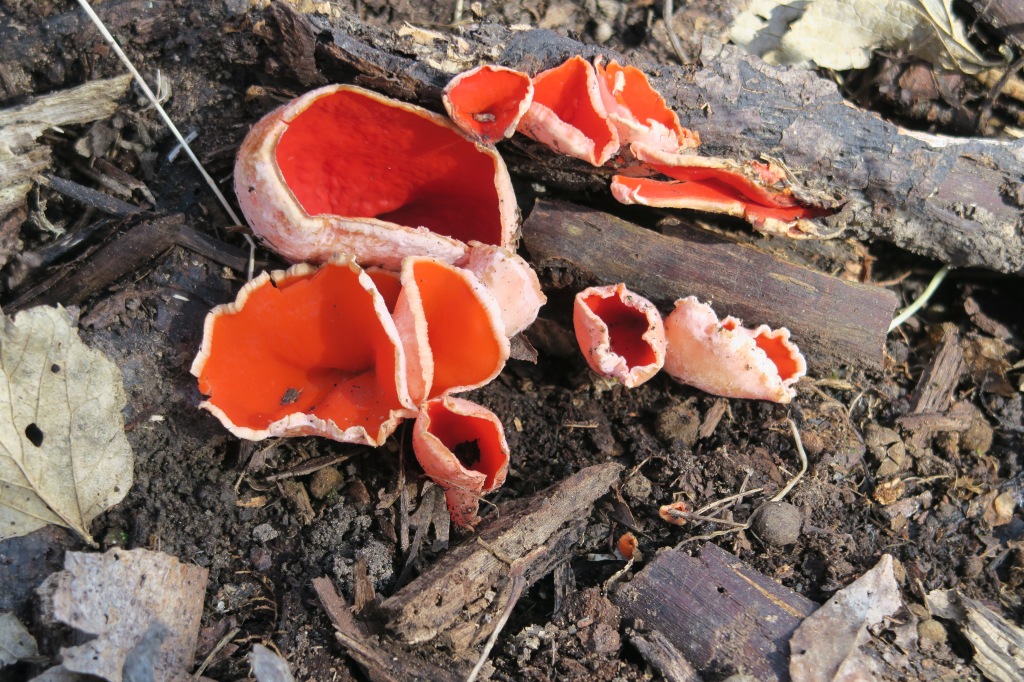April 6, 2020
In this difficult time Bill and I are also staying in place. But we are fortunate to be living in the middle of a 200-acre private nature preserve. Our place is surrounded by woodland and prairie bordered by a county road and two creeks. We’re the only human residents. Here’s what’s happening this week.

Sarcosypha dudleyi, Crimson Cup
Sarcosypha dudleyi, Crimson Cup mushroom is now fruiting abundantly on downed basswood along Brush Creek east of the house. A harbinger of spring I have occasionally seen it fruiting on warm January days. The deeply incurved cup flattens as the mushroom matures. The bright red inner surface is smooth while the white outer surface is composed of loose cottony material. The length of the short, wide stalk varies according to the depth at which the sticks are buried.
In Iowa this species used to be recognized as S. coccinea. But S. coccinea is found only in the Pacific Northwest whereas S. dudleyi is found in eastern North America. The two species can only be separated by their microscopic features.
Crimson cup was used as medicinal plant by Oneida Indians. They applied the dried and ground up fungus as a styptic to the navels of newborn children who were not healing properly after their umbilical cord was cut. Ground up fruit bodies were also used under soft-tanned deerskin bandages.

Dumontinia tuberosa, Anemone cup
One expects to find Crimson Cup mushrooms early in the season but finding another cup fungus so early in the season is always gratifying. Anemone cups, Dumontinia tuberosa, are also fruiting in our open woodlands. Widely distributed but not commonly collected in eastern North America from New York to North Dakota and south to Tennessee this fungus fruits in early spring, March through May. Ada Hayden Herbarium at Iowa State University lists collections from Winneshiek, Marshall, Boone, Johnson, Iowa, Decatur and Story counties. D. tuberosa is the only member of the genus. The underground portion consists of a long, slender stalk attached to a long, irregularly-shaped sclerotium, a compact mass of hardened mushroom tissue. Above ground, the stalk expands into a pale umber-brown cup, 1-3 cm. wide.
Historically Dumontinia tuberosa has been regarded as a parasite of Anemone “but a more complex relationship may exist between the two organisms.” (Elliott et al)I have dug up several specimens. None were associated with the roots of another plant although Rue Anemone, Anemone thalictroides, is blooming nearby.
In Europe it is known to parasitize the rhizomes of Anemone nemerosa. Since it is “parasitic on European species of anemone it has always been assumed that must also be the case in North America. But it is uncertain whether it is associated with any American species of Anemone. Mycologist Fred Seaver collected hundreds of specimens and “in no case has the fungus been associated with the rhizomes of any host. While there might be a mycelial connection, none was apparent.” (Seaver) It may also be that the American form of this species differs from the European.
References:
Fred J. Seaver. The North American Cup-fungi (Inoperculates). Lancaster: Lancaster Press, 1951:p. 76 Beug, Bessette & Bessetrte. Ascomete Fungi of North America. University of Texas